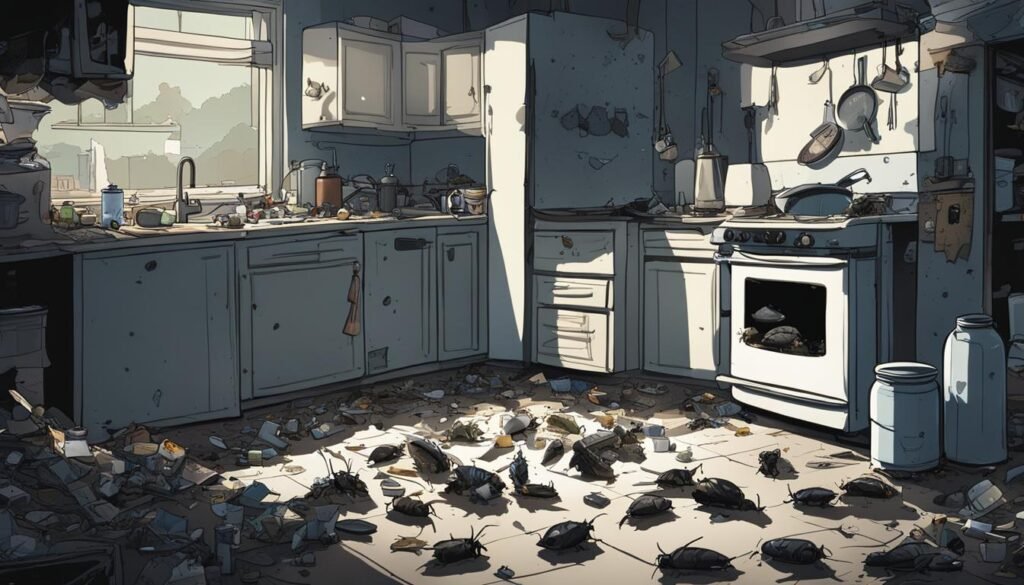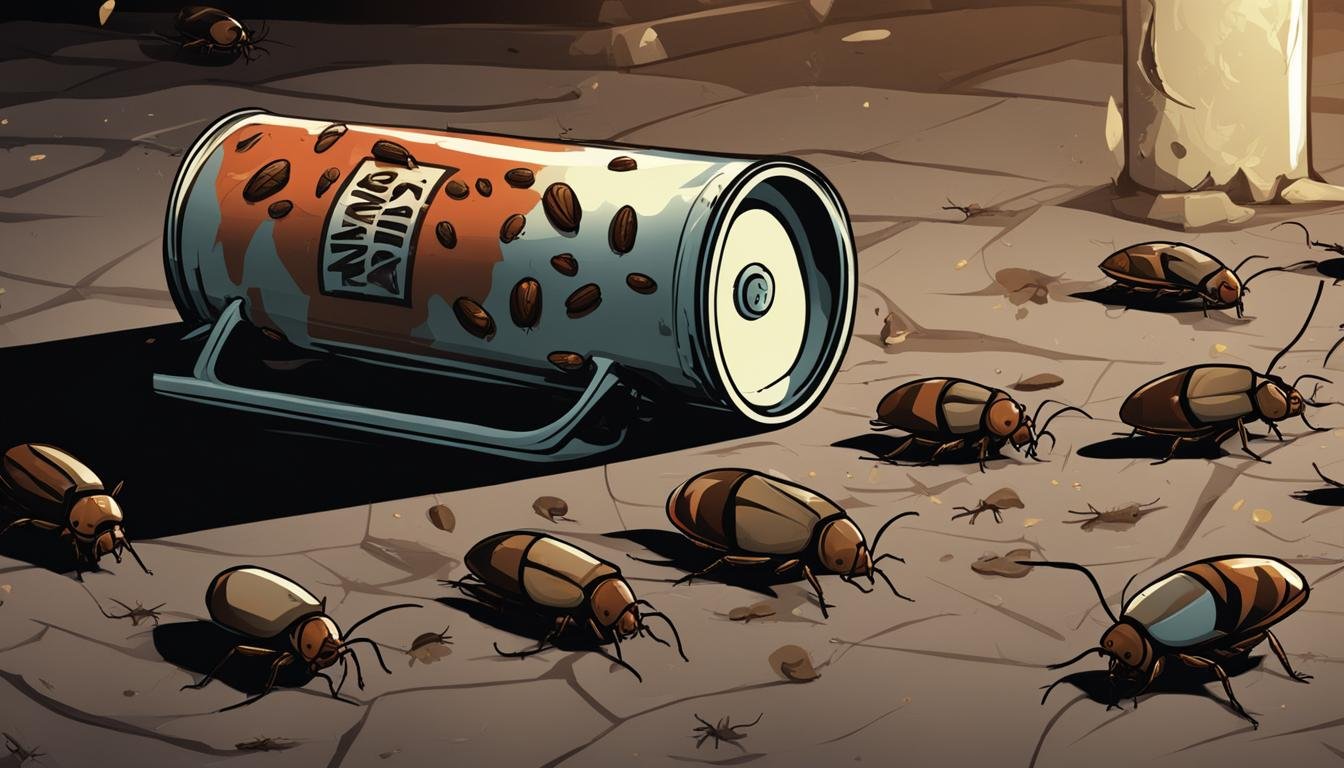Have you ever wondered why you still see roaches scurrying around your home after using a bug bomb? It can be frustrating to think that your efforts to eliminate these unwanted pests were in vain. In this article, we will explore the reasons behind this phenomenon and shed light on the effectiveness of home pesticides in dealing with roach infestations.
Key Takeaways:
- Using bug bombs or insect foggers may not fully eliminate roaches in your home.
- These products have limited reach and may not target hidden areas where roaches hide.
- Roaches can come out of hiding, unaffected by the pesticide, leading to an increase in their presence.
- Bug bombs pose safety risks if not used correctly, making multiple treatments undesirable.
- Considering alternative pest control methods and professional assistance may be necessary for effective roach control.
What are Bug Bombs and How Do They Work?
Bug bombs, also known as insect foggers, are popular do-it-yourself pest control products that are designed to eliminate cockroaches and other pests. These pressurized cans or devices release a stream of pesticides into the air, creating a fog or mist that settles on surfaces where pests are likely to come into contact with it.
Bug bombs work by targeting open areas where pests walk along, such as floors, countertops, and furniture. When the fog or mist comes into contact with the roaches, it can kill them on contact or cause them to ingest the pesticide, leading to their demise. This can provide a quick solution to visible roach problems in your home.
However, it’s important to note that bug bombs have limitations in their effectiveness. They may not reach all the hidden areas where roaches hide, such as cracks, crevices, and behind appliances. This means that while bug bombs can help reduce the visible roach population, they may not fully eliminate the infestation or prevent future roach activity.
It’s also crucial to follow the instructions carefully when using bug bombs to ensure your safety and the effectiveness of the product. These instructions typically include covering or removing food, dishes, and utensils, turning off pilot lights and other sources of ignition, and leaving the treated area for the recommended period of time.
Why Do I Still See Roaches After Bombing?
Even though you’ve used a bug bomb to tackle a roach infestation, it can be disheartening to still see roaches crawling around your home after the treatment. This may leave you wondering why the bug bomb didn’t fully eliminate the problem. There are several reasons why you may still see roaches after bombing, including hidden roaches, the ineffectiveness of bug bombs, the hatching of new eggs, and roach migration.
One reason you may still see roaches is that some of them may have hidden away in hard-to-reach spots during the bug bomb treatment. These hidden roaches may not have been impacted by the pesticide, allowing them to continue thriving and reproducing. Bug bombs primarily target open surfaces, but they may not reach the cracks and crevices where roaches like to hide.
Another reason for the continued presence of roaches is the effectiveness of bug bombs. While bug bombs can kill adult roaches, they may not be as effective in eliminating eggs and nymphs. Roaches reproduce rapidly, and even if the adult population is eliminated, any remaining eggs can hatch and lead to a new generation of roaches. This is why multiple treatments are often necessary to achieve total eradication.
Furthermore, roaches can migrate from adjacent areas into your home, even if you don’t have an active infestation. If neighboring units or buildings have roach problems, the pests may find their way into your living space. In such cases, addressing the source of the infestation in addition to using bug bombs is crucial to prevent roaches from returning.

Hidden Roaches
- Bug bombs may not reach roaches hiding in cracks and crevices.
- Hidden roaches can continue to thrive and reproduce even after a bug bomb treatment.
Ineffectiveness of Bug Bombs
- Bug bombs may not fully eliminate roach eggs and nymphs.
- Roaches can quickly reproduce, resulting in a new generation of pests.
Hatching of New Eggs
- If not all eggs are eliminated, they can hatch and contribute to the infestation.
- Multiple treatments are often necessary to achieve total eradication.
Roach Migration
- Roaches can migrate from adjacent areas into your home, even without an active infestation.
- Tackling the source of the infestation is crucial to preventing their return.
Bug Bombs and Hidden Roaches
When it comes to using bug bombs to combat roach infestations, one of the main challenges is targeting hidden roaches. These pesky pests have a knack for finding hiding spots that are difficult to reach and treat with standard bug bombs. While bug bombs can effectively impact roaches that are out in the open, they often fall short in addressing the hidden population.
To effectively target hidden roaches, alternative treatments such as crack and crevice treatments and baited poisons can be employed. Crack and crevice treatments involve applying the pesticide directly into the cracks and crevices where roaches hide, ensuring better coverage and efficacy. Baited poisons, on the other hand, use attractants to lure roaches out of their hiding spots and then deliver a lethal dose of poison. These methods can be more effective in reaching the hidden roach population and managing the infestation.
Understanding Cockroach Behavior
In order to effectively combat hidden roaches, it’s important to understand their behavior. Cockroaches are nocturnal creatures that prefer dark, warm, and humid environments. They tend to congregate in areas such as kitchen cabinets, under appliances, and behind walls. By targeting these common hiding spots with crack and crevice treatments or baited poisons, it is possible to disrupt their populations and limit their ability to reproduce.
List of effective treatments for hidden roaches:
- Crack and crevice treatments
- Baited poisons
- Pest-proofing your home
- Professional pest control services
By utilizing these targeted treatments and taking steps to prevent reinfestation, you can significantly improve your chances of eliminating hidden roaches and achieving long-term roach control.
What If the Bug Bomb Doesn’t Work?
While bug bombs can be a convenient option for tackling roach infestations, they may not always deliver the desired results. In some cases, a single bug bomb may not be strong enough to fully eliminate the infestation. This can be frustrating, but it’s important to remember that there are other options available.
If you find that the bug bomb hasn’t effectively eradicated the roach population in your home, it’s not advisable to simply use multiple bug bombs. Using multiple bug bombs can pose safety risks and may not significantly improve the outcome. Instead, it may be time to consider seeking professional pest control services.
Professional pest control technicians have the knowledge, experience, and specialized products to target and eliminate roach infestations effectively. They can assess the extent of the infestation, identify the source, and implement a comprehensive treatment plan. By relying on professionals, you can increase the chances of fully eradicating the roach problem and preventing future infestations.
The Continued Presence of Roaches From New Eggs
Even after using bug bombs to control a roach infestation, it can be frustrating to discover that you are still seeing these pests in your home. One possible reason for this is the hatching of new roach eggs that were not affected by the pesticide treatment. Roaches are known for their rapid reproduction, and if even a few eggs remain untouched, they can quickly develop into adult roaches, leading to a continued infestation.
To achieve total eradication of roaches, it is crucial to eliminate both the adult roaches and their young. Bug bombs may be effective in targeting adult roaches, but they may not fully eliminate the eggs or nymphs. This is why multiple treatments are often necessary to ensure complete eradication of the infestation. By continuing to address the roach population at different stages of their life cycle, you increase the chances of effectively controlling the problem and preventing its recurrence.
It is important to understand that the presence of new eggs is a common challenge when dealing with roach infestations. However, by implementing comprehensive pest control measures and combining them with proper sanitation practices, you can significantly reduce the likelihood of new eggs hatching and continuing the infestation. Consider utilizing crack and crevice treatments or baited poisons that can target hidden roaches and prevent them from reproducing.
Preventing Roach Infestations
- Maintain a clean and sanitary environment by regularly cleaning and vacuuming your home.
- Seal any cracks or openings in walls, floors, and windows to prevent roaches from entering your home.
- Store food in airtight containers and promptly clean up any spills or crumbs to remove potential food sources for roaches.
- Fix any plumbing leaks or moisture issues, as roaches are attracted to damp environments.
- Consider professional pest control services for a thorough and effective roach elimination.
By taking proactive measures and addressing the problem holistically, you can increase the chances of achieving long-term success in managing roach populations and preventing their return.

Roach Migration and Infestation Sources
If you’ve used bug bombs to control roaches in your home and still find them lingering, it’s possible that roach migration and adjacent infestations are contributing to the problem. Roaches are resilient creatures and can migrate from neighboring units or buildings, finding their way into your home. Addressing the source of the infestation is crucial to effectively eliminate roaches.
To prevent roaches from returning, it’s important to consider pest control options that target both the infestation in your home and the potential sources outside. This may involve contacting professional pest control services that can assess and treat the adjacent areas where roaches may be coming from. By addressing the root cause of the infestation, you can achieve long-term success in managing roach populations.
Preventing Roach Migration
- Seal cracks and crevices: Roaches can enter your home through tiny cracks and crevices. Seal any openings to prevent their migration.
- Maintain cleanliness: Proper sanitation reduces the attractiveness of your home to roaches and minimizes the chances of migration.
- Eliminate food sources: Roaches are drawn to food, so store it in airtight containers and clean up spills promptly.
Professional Pest Control
If you’re struggling with a persistent roach problem, it may be beneficial to consult a professional pest control agency. They have the expertise and tools to identify the extent of the infestation, locate adjacent sources, and provide targeted treatment. Professional pest control can help ensure a thorough eradication of roaches and prevent future migration into your home.
Conclusion
In conclusion, while bug bombs may offer a quick solution to roach problems, they may not completely eradicate the infestation. It is important to understand the limitations of bug bombs and explore alternative pest control methods for more effective roach control and prevention.
Consider options such as crack and crevice treatments or baited poisons, which can effectively target hidden roaches that bug bombs may not reach. Additionally, professional pest control services can provide comprehensive treatments tailored to your specific situation.
Maintaining proper sanitation and addressing potential sources of infestation are also crucial for long-term success in managing roach populations. By adopting effective pest management practices, you can minimize the presence of roaches in your home and ensure a pest-free environment.
FAQ
Why do I see more roaches after bombing?
After using a bug bomb, it is possible to still see roaches in your home due to hidden roaches, the ineffectiveness of bug bombs, hatching of new eggs, and roach migration.
What are bug bombs and how do they work?
Bug bombs, also known as insect foggers, are pressurized cans or devices that release pesticides into the air, targeting open surfaces where pests may walk along. They work by creating a fog of pesticide that aims to eliminate roaches and other pests.
Why do I still see roaches after bombing?
Roaches may still be present after bombing due to hidden roaches that were not impacted by the pesticide, the limited effectiveness of bug bombs, the hatching of new eggs that were not affected by the treatment, and the migration of roaches from adjacent areas.
How are hidden roaches affected by bug bombs?
Bug bombs may not effectively reach hidden roaches that spend their days hiding away in hard-to-reach spots. While foraging roaches may be impacted by the pesticide, the hidden population can continue to thrive and reproduce. Crack and crevice treatments and baited poisons may be more effective in targeting hidden roaches.
What should I do if the bug bomb doesn’t work?
If a bug bomb does not work, it may be necessary to consider contacting a professional pest control agency for more effective treatment. Using multiple bug bombs is generally not recommended due to safety concerns.
Why is the presence of new eggs a problem even after using a bug bomb?
Even if a bug bomb eliminates the adult roaches, an infestation can continue if any new eggs hatch and grow into adults. Roaches reproduce quickly, and the failure to eliminate eggs or nymphs can result in a thriving infestation. Total eradication requires multiple treatments designed to eliminate both adult roaches and their young.
Can roaches migrate into my home from neighboring areas?
Yes, roaches can migrate from adjacent areas into your home, even if you don’t have an active infestation. If roaches are coming from neighboring units or buildings, it can be difficult to fully eliminate the infestation without addressing the source. Pest control options should be explored to prevent roaches from returning.
What is the key to effective roach control?
While bug bombs may provide a quick solution to roach problems, they may not fully eliminate the infestation. Understanding the limitations of bug bombs and considering alternative pest control methods, such as crack and crevice treatments, baited poisons, and professional pest control services, can lead to more effective roach control and prevention. Maintaining proper sanitation and addressing any potential sources of infestation are key steps in achieving long-term success in managing roach populations.

